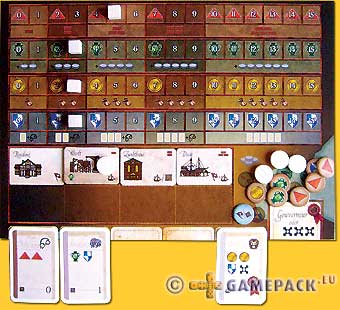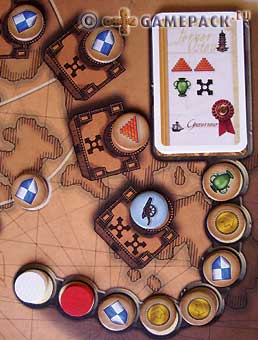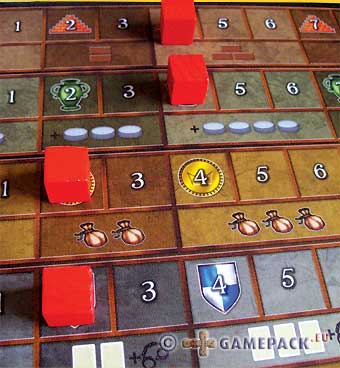Magister Navis / Endeavor
Authors: Carl de Visser & Jarrat Gray
Publisher: Lookout Games / Heidelberger Spieleverlag / Z-Man Games
Year: 2009
review by

| x |
|
|
|
|
|
|
|
|
|
|
|
|
|
|
|
|
|
|
|
|
|
|
|
|
|
|
|
|
|
|
|
|
|
|
|
|
|
|
|
|
|
|
|
|
|
|
 |
Europe, the 18th century. Large parts of the world are still undiscovered. These unexplored regions with their unimaginable wealth attract the European sea going empires; adventure, wealth and glory will be the reward of sailor that are willing to accept the challenge! In Magister Navis, the players sail the seven seas to discover new lands, form alliances and establish shipping tracks, so that the folks back home can also benefit from the local specialties. Whoever manages to build the wealthiest and most powerful empire wins the game!
|
|
| x |
|
|
|
|
|
|
|
|
|
|
|
|
|
|
|
|
|
|
|
|
|
|
|
|
|
|
|
|
|
|
|
|
|
|
|
|
|
|
|
|
|
|
|
|
|
|
|
The board shows seven regions: our starting territory Europe, and six unexplored regions. All regions contain cities that are connected to each other. The six unexplored regions also depict a shipping track; only after this track has been filled up completely with ships, the region is considered 'open' and other actions can be performed in this area.
|
|
 |
|
| x |
|
|
|
|
|
|
|
|
|
|
|
|
|
|
|
|
|
|
|
|
|
|
|
|
|
|
|
|
|
|
|
|
|
|
|
|
|
|
|
|
|
|
|
|
|
|
 |
Each player has a player board on which he places his buildings and cards, and which depicts four status tracks (industry, culture, finance and politics) where the players can further develop their skills. These tracks determine which buildings players are allowed to build, how many population markers they receive each round, how many workers they can pay and how many cards they may possess.
|
|
| x |
|
|
|
|
|
|
|
|
|
|
|
|
|
|
|
|
|
|
|
|
|
|
|
|
|
|
|
|
|
|
|
|
|
|
|
|
|
|
|
|
|
|
|
|
|
|
|
Each round, all players build one building, and they place new population markers in their harbour. This is followed by the action phase, where players take turns performing one action at a time until all have passed. There are two ways to perform an action: by using a trade token that depicts the desired action, or by activating a building. In the latter case, one population marker is placed on the building; as long as this marker remains there, this building cannot be used again. Only in the salary phase, when the workers are paid, they return to the harbour.
|
|
|
|
| x |
|
|
|
|
|
|
|
|
|
|
|
|
|
|
|
|
|
|
|
|
|
|
|
|
|
|
|
|
|
|
|
|
|
|
|
|
|
|
|
|
|
|
|
|
|
|
 |
|
In the action phase, players can place population markers in the cities or the shipping tracks. The cities and the shipping tracks contain trade tokens that sometimes depict an action, but more often the symbol of one of the status tracks. When a player places a population marker in a city or on a shipping track, he places the token in his harbour. Tokens depicting an action can be used later in the game to perform the corresponding action. If the token depicts the symbol of one of the status tracks, the player advances the marker on the corresponding track.
|
|
| x |
|
|
|
|
|
|
|
|
|
|
|
|
|
|
|
|
|
|
|
|
|
|
|
|
|
|
|
|
|
|
|
|
|
|
|
|
|
|
|
|
|
|
|
|
|
|
|
Population markers in the cities score victory points at the end of the game. If a player occupies two cities that are connected to each other, he may also take the token that is positioned between these two cities. This connection is also rewarded with a victory point at the end of the game. Using the action 'attack', players can take over cities that have already been claimed by an opponent, thus stealing victory points away from each other.
|
|
 |
|
| x |
|
|
|
|
|
|
|
|
|
|
|
|
|
|
|
|
|
|
|
|
|
|
|
|
|
|
|
|
|
|
|
|
|
|
|
|
|
|
|
|
|
|
|
|
|
|
 |
Population markers on shipping tracks do not result in victory points, but presence on these tracks is very important. For starters, only when a shipping track is filled up with population markers further actions can be performed in this region. Secondly, only players that are present on the shipping track are allowed to perform actions in the corresponding region.
|
|
| x |
|
|
|
|
|
|
|
|
|
|
|
|
|
|
|
|
|
|
|
|
|
|
|
|
|
|
|
|
|
|
|
|
|
|
|
|
|
|
|
|
|
|
|
|
|
|
|
In addition to occupying cities, asset cards can be collected in the various regions using the action 'draw cards'. A player may only collect an asset card if he possesses a number of population markers in this area at least equal to the number depicted on the card (0-5). The asset cards show victory points and/or symbols; for each of the symbols, the player increases his position on the corresponding status track.
|
x |
|
|
| x |
|
|
|
|
|
|
|
|
|
|
|
|
|
|
|
|
|
|
|
|
|
|
|
|
|
|
|
|
|
|
|
|
|
|
|
|
|
|
|
|
|
|
|
|
|
|
 |
|
At the end of each round all players have to check their card limit, which is determined by their position on the politics track. If a player has to turn in one or more cards, he also has to readjust his status tracks accordingly; only while the asset cards are in his possession, he profits from the benefits of the card!
After seven rounds the game is over. The population markers in cities and their connections are counted, as well as the victory symbols on the buildings and asset cards of each player. Their position on the four status tracks is also converted into victory points. The player with the highest score wins the game!
|
|
| x |
|
|
|
|
|
|
|
|
|
|
|
|
|
|
|
|
|
|
|
|
|
|
|
|
|
|
|
|
|
|
|
|
|
|
|
|
|
|
|
|
|
|
|
|
|
|
 |
| x |
|
|
|
|
|
|
|
|
|
|
|
|
|
|
|
|
|
|
|
|
|
|
|
|
|
|
|
|
|
|
|
|
|
|
|
|
|
|
|
|
|
|
|
|
|
|
| x |
|
|
|
|
|
|
|
|
|
|
|
|
|
|
|
|
|
|
|
|
|
|
|
|
|
|
|
|
|
|
|
|
|
|
|
|
|
|
|
|
|
|
|
|
|
|
| x |
|
|
|
|
|
|
|
|
|
|
|
|
|
|
|
|
|
|
|
|
|
|
|
|
|
|
|
|
|
|
|
|
|
|
|
|
|
|
|
|
|
|
|
|
|
|
 |
|
|
|
|
|
|
|
|
|
|
|
|
|
|
|
|
|
|
|
|
|
|
|
|
|
|
|
|
|
|
|
|
|
|
|
|
|
|
|
|
|
|
|
Magister Navis is a beautiful game with a very clear board. The only thing that is missing is a player aid summarising all the possible actions and the different phases of the game.
|
|
| x |
|
|
|
|
|
|
|
|
|
|
|
|
|
|
|
|
|
|
|
|
|
|
|
|
|
|
|
|
|
|
|
|
|
|
|
|
|
|
|
|
|
|
|
|
|
|
 |
|
| x |
|
|
|
|
|
|
|
|
|
|
|
|
|
|
|
|
|
|
|
|
|
|
|
|
|
|
|
|
|
|
|
|
|
|
|
|
|
|
|
|
|
|
|
|
|
|
|
A very nice element is than players can really develop their empire during the game. Every new building enables them to carry out new actions, and each step on the status tracks gives new opportunities. This makes it possible to make a strategic plan; a player can for example decide to mainly collect asset cards, and therefore concentrate on developing his politics tracks (which determines his card limit), and choose buildings that enable him to draw asset cards.
|
|
  |
|
| x |
|
|
|
|
|
|
|
|
|
|
|
|
|
|
|
|
|
|
|
|
|
|
|
|
|
|
|
|
|
|
|
|
|
|
|
|
|
|
|
|
|
|
|
|
|
|
 |
|
On the other hand, a player that concentrates on his presence on the board benefits from buildings that allow the actions 'occupy' and 'attack'. Since these actions cost more population markers, he can invest in his development on the culture track (which determines how many new population markers he receives each round). |
|
| x |
|
|
|
|
|
|
|
|
|
|
|
|
|
|
|
|
|
|
|
|
|
|
|
|
|
|
|
|
|
|
|
|
|
|
|
|
|
|
|
|
|
|
|
|
|
|
|
The game offers a lot of player interaction. They can fight each other in the cities, and they compete for presence on the shipping track and for the asset cards in the regions. The game plays best with five players, because of the competition for the limited space on the board. At first instance the game plays very fast; the first three rounds are over in no time. But, when the game advances, players have more buildings, markers and actions to perform, the choices become more difficult and the rounds get longer. All in all, the game takes approximately 90 minutes, but those 90 minutes are full of fun!
© 2010 Barbara van Vugt
Magister Navis, Carl de Visser & Jarrat Gray, Lookout Games / Heidelberger Spieleverlag, 2009 - 3 to 5 players, 12 years and up, 90 minutes
|
|
  |
|
|
|
|
|
|
|
|
|
|
|
|
|
|
|
|
|
|
|
|
|
|
|
|
|
|
|
|
|
|
|
|
|
|
|
|
|
|
|
|
|
|
  |
|
|
|
|
|
|
|
|
|
|
|
|
|
|
|
|
|
|
|
|
|
|
|
|
|
|
|
|
|
|
|
|
|
|
|
|
|
|
|
|
|
|
  |
Basic game that yet is fun to play |
  |
|
|
|
|
|
|
|
|
|
|
|
|
|
|
|
|
|
|
|
|
|
|
|
|
|
|
|
|
|
|
|
|
|
|
|
|
|
|
|
|
|
|
  |
Fluidly playing game with lots of different paths leading to victory |
  |
|
|
|
|
|
|
|
|
|
|
|
|
|
|
|
|
|
|
|
|
|
|
|
|
|
|
|
|
|
|
|
|
|
|
|
|
|
|
|
|
|
|
  |
|
|
|
|
|
|
|
|
|
|
|
|
|
|
|
|
|
|
|
|
|
|
|
|
|
|
|
|
|
|
|
|
|
|
|
|
|
|
|
|
|
|
| x |
|
|
|
|
|
|
|
|
|
|
|
|
|
|
|
|
|
|
|
|
|
|
|
|
|
|
|
|
|
|
|
|
|
|
|
|
|
|
|
|
|
|
|
|
|
|
| x |
|
|
|
|
|
|
|
|
|
|
|
|
|
|
|
|
|
|
|
|
|
|
|
|
|
|
|
|
|
|
|
|
|
|
|
|
|
|
|
|
|
|
|
|
|
|
 |
|
|
|
|
|
|
|
|
|
|
|
|
|
|
|
|
|
|
|
|
|
|
|
|
|
|
|
|
|
|
|
|
|
|
|
|
|
|
|
|
|
|
 |
|
|
|
|
|
|
|
|
|
|
|
|
|
|
|
|
|
|
|
|
|
|
|
|
|
|
|
|
|
|
|
|
|
|
|
|
|
|
|
|
|
|
| x |
|
|
|
|
|
|
|
|
|
|
|
|
|
|
|
|
|
|
|
|
|
|
|
|
|
|
|
|
|
|
|
|
|
|
|
|
|
|
|
|
|
|
|
|
|
|
 |
|
|
|
|
|
|
|
|
|
|
|
|
|
|
|
|
|
|
|
|
|
|
|
|
|
|
|
|
|
|
|
|
|
|
 |
|
|
|
|
|
|
|
|
|
|
|
|
|
|
|
|
|
|
|
|
|
|
|
|
|
|
|
|
|
|
|
|
|
|